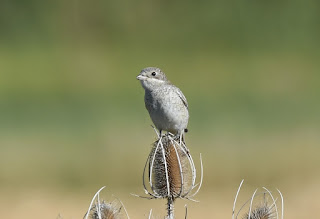One of the themes of this trip was finding things around the village and nearer-by than we imagined, like these Black-bellied Sandgrouse which could be found daily along the track to Huescar.
I took a lot of Sandgrouse photos but only have access to a few due to changing laptops, there are sometimes more, and better, images on my Facebook page. Just a temporary problem though, hopefully all sorted now. One of the most important things to check when we got to Galera was the status of our resident Trumpeter Finches. Staking out the Water Tower had the desired effect and it was quite clearly another successful breeding season with good numbers of juveniles present. It's difficult to be sure of numbers overall now but the birds have excited some interest and visits were made by local naturalists Mick Richardson and Juan Perez de Ana with the latter recording 50 birds at least. The leak at the Water Tower is the best place for photos.
The normal Thursday visit to Huescar market gave a chance to watch Pallid Swifts coming to their nests in an old building on the corner of a small square. Always great to watch and always difficult to photograph as they scream in and out.
Black Wheatears are common enough, virtually a garden bird but always a bit shy so a reasonable chance to get a photo of one reasonably close and settled is not to be missed.
One of the great things about spending time in Southern Spain is the opportunity to catch up with a wide range of wildlife. These Viperine Snakes, juvenile and adult here, are pretty much guaranteed wherever there's water. Love 'em even if not every one does.
Another common bird, locally, usually in the scrubby maquis is Spectacled Warbler. They aren't easy to get to grips with but this youngster really showed well. Pleased with these pics.
A couple of previous themes, wider wildlife and local stuff. I just didn't realise Spanish Ibex were in the area and we were delighted to come across this bunch feeding in a field next to a really deep and impressive ravine where is home, clearly.
Pretty boy here was up a mountain in Baza and quite unconcerned about us. A typical Red Fox, some of the individuals in the drier areas look very different with finer coats and bigger ears, quite North African in fact.
This juvenile Short-toed Eagle frequented the track to Huescar, a common bird in summer though perhaps slightly less common than Booted.
The star Butterfly hereabouts is Black-winged Green, found only in two small sites in Spain, otherwise a North African species. Haven't found it yet but there are plenty of these Scarce Swallowtails which are actually pretty unscarce but certainly impressive.
Dragonflies are one of the wonders of this part of the world and there are plenty we haven't seen yet. We caught up with Large Pincertail for the first time and also Violet Dropwing (two pics below). A North African and tropical species which has colonised Spain and Southern France in the last 30 years. In my view the best looking dragonfly you can get. Also Broad Scarlet (Scarlet Darter) and Red-veined Darter below.
Another bird along the very productive Huescar track, a juvenile Woodchat Shrike.
And yet another from the same place, not really common locally, Black Kite.
And some local humans, well 4,000 years ago humans. Images from the cuevas des letreros near Velez Blanco. Unassuming but with great weight. Give me the real thing over an interactive or interpretive experience any day. Ibex below.
And to finish, the much maligned and overlooked Feral Pigeons (NOT) or almost not anyway. Very little evidence (but some) of anything other than pure Rock Dove genes out in the campo. It's different in the towns and villages but quite encouraging in the countryside. These were breeding in the gorge at Castril.
Oh and back in January. Can't wait.
































No comments:
Post a Comment